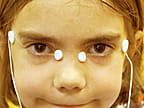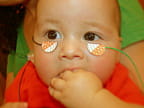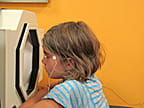In our retinas we have rod cells and cone cells. Our rod cells allow us to see at night, and our cone cells help us see in daylight. An electroretinogram (ERG) is used to make sure these cells are doing their jobs. The ERG consists of two phases: dark and light.
Your rod cells are checked in the dark phase and your cone cells are tested in the light phase. In both phases, we use the machine with the flashing lights. Just like in the VEP, electrodes are used for recording. For this test a different type of electrode will be placed either on your eyes or on your lower lids. The ERG takes about 60-90 minutes from start to finish.
Electroretinogram Phases
The electroretinogram consists of the dark phase and the light phase.
Dark phase
We begin the dark phase by putting drops in your eyes to dilate your pupils. Next, both eyes are covered with patches to keep you from being able to see any light for 30 minutes. When the patches are removed, you will be seated in front of the machine with the flashing lights. The lights will come in single flashes that gradually get brighter and may also be different colors as the test moves along.
Light phase
To properly check your cone cells, your eyes must first readjust to the light, so you will sit in a lit room with your eyes open. After 10 minutes, you will go back to sitting in front of the machine. Single flashes of white light are followed by what looks like a strobe light that lasts for a few seconds. Finally, the electrodes are removed and the testing is complete.












